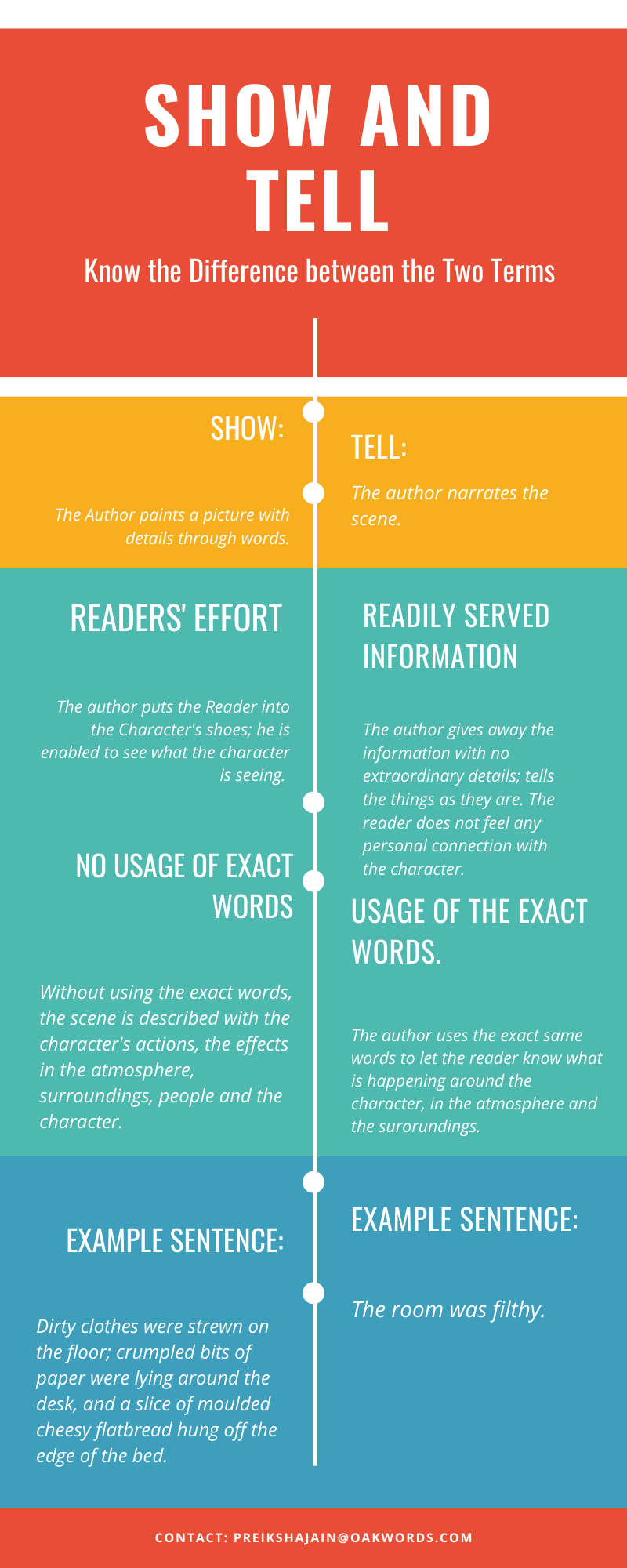
Show don’t Tell. We often hear this from critics, readers, mentors, teachers in the writing field and they leave it up to us to understand what they mean by ‘show don’t tell’. Which ultimately leaves us, the writers with a never-ending struggle of ‘how to show and not tell’.
“Winston Smith, his chin nuzzled into his breast in an effort to escape the vile wind, slipped quickly through the glass doors of Victory Mansions, though not quickly enough to prevent a swirl of gritty dust from entering along with him.”
– George Orwell, 1984
Upon reading this sentence, one can infer that it was a cold day and that the character was trying to keep himself warm. But nowhere in the sentence have the words ‘cold’ or ‘trying to keep himself warm’ been used.
As a new writer, we almost always fall victim to the situation where we ‘tell’ too much and ‘show’ too less; our writing is too narrative but far less deptictive.
Tweet
Showing Vs Telling: Know the difference

Now, when a writer is writing ‘The weather was too cold for her liking’, I am certain, it would sound too bland and too boring for even the reader in him/her. You would want that nice, maybe somewhat poetic sentence to ‘show’ you how it was cold, what its impact was on the surroundings.
Take a look at these show don’t tell examples:
“The hood of her car was covered under a 3-inch thick blanket of snow; with knitted brows, gritting teeth and whispering a ‘fuck’, she stomped her foot on the ground which further dug into the snow.”
– Preiksha Jain
Here, I did not use the word ‘dislike’, ‘cold’, or ‘frustration’. Instead, I left it open for the reader to draw his own conclusions, interpretations and visualisations.
By Showing, we let the reader ‘see’ what is happening in the scene, instead of narrating it to him and blocking the way for his imagination. By Showing, we bring the reader right before the scene for them to experience it on their own.
Tweet
You make the reader a part of your character’s life, experiences; the reader builds his/her notion about the characters or the places without you telling him to. a good writer will not simply, blandly ‘tell’ that there was snow, instead, s/he will show it to the reader in his story how the snow had covered everything in the driveway or the parking lot.
7 Simple Tips for Show don’t tell in writing
#1. Show your setting
One of the most effective ways of showing rather than telling is to create a strong sense of setting. A story setting where you show every element will enrich your plot events with mood, atmosphere, context, and contrasts. Use the senses – smell, sight, sound, touch, and combine all of them to create a strong setting.
But don’t overdo it. Show your readers what is relevant and avoid including every detail. Try to describe the setting in a refreshing, new way.
#2. Dialogues to show characters’ relationships
Dialogues are one of the most powerful tools used by authors to avoid telling. They are the best way to show a conversation, the expressions on the faces, the nature of someone in the story, the personality of the person. Authors, over the years, have been using dialogue to show their character’s relationships, their personalities, and much more.
#3. Avoid Adjectives
You do not have to use adjectives like tall, hungry, angry, cold etc. Pick up the detail such as: know how someone reacts when they are angry, notice their expressions: are they grinding their teeth? Are they clenching their jaw? Are they tightening their grip on something? In other words, do not exploit the generic terms; use something more revealing.
#4. Look for Adverbs
Besides adjectives, avoid adverbs too: because if you write ‘slowly’ it won’t show how slow, or what happened when the pace got slow, what the character did when he walked slowly. So, do not use adverbs; replace them with the impact of those adverbs.
#5. Avoid ‘Telling’ Verbs
If you want to follow the ‘show don’t tell’ rule, avoid using the telling verbs like wondered, smelled, saw, thought, heard. These are telling verbs that put the reader out of a character’s experiences.
#6. Personify Emotion
More than anything else, authors want to immerse their readers into their character’s lives, and the stories’ emotional arcs. They want readers to connect with their characters and their emotions.
This is hard to accomplish by merely telling about the emotion. You’ve to give life to those emotions by personifying them. Show don’t tell. Stop using words like happily, sadly, amazement, wonder, and make your characters convey these emotions through action or dialogues.
She was angry.A wave of roiling anger took root within her.He was afraid.A cold of sweat broke over his temple.
#7. Use Metaphors
You can also use metaphors to follow the concept of ‘show don’t tell.’ They are a great tool to make your writing more fun and descriptive. So, use metaphors, similes, and comparisons to awaken emotions, set mood, and trigger memories.
Show don’t tell examples:
Take a look at these show don’t tell examples:
He was tired? Nah.
Try: He yawned and rubbed his eyes.
She hated the smell of cigarettes on him. Too bland.
Try: When she neared him, the stench of tobacco wafted off of him and she scrunched her nose and immediately took a step away.
Theo loved to gossip.
Well, let us try that: Theo’s eyes glinted and his brows danced as he overheard someone talking about Reena having an affair with her ex. (Juicy, right?)
The fall had arrived. Oh, is that so? How do I know?
Take a look at this: Taking another step, she looked up to see a yellow-orange leaf losing its grip with the branch; the October air catching and taking it away.
Show don’t tell is not a license to overwrite – Don’t Overdo it!
Good writing is a mix of both showing and telling. Writing that only tells is boring. And writing that only shows can be so overwhelming that it detracts from the story.
Telling is as important as Showing. You would not want your reader to get bored with imagining too much and not getting to the main story. There are things which will require immediate narration, short, undetailed information which will maintain the pace of the story.
Instead of mentioning the minutest details of someone getting ready to commit a murder i.e the nervousness, getting in the car, honking relentlessly, avoiding collision with other cars, getting out of the car and reaching the determined place, you can simply write:
“Escaping a death ride, he reached her house. Gliding in stealthily, he quickly scanned the whole place wiping sweat from his forehead, and tiptoed towards the backyard where she was standing, unaware of the upcoming danger.”
‘Show and not tell’ is great, but with a balance of both, your writing can be both expressive and narrative. The reader will visualise the scene alongside knowing the relevant information in it. In short, don’t be so rigid about ‘show don’t tell,’ that you forget about the importance of telling.
Still Confused about ‘Show don’t tell’?
If you still feel you don’t have a strong sense of this ‘show don’t tell’ rule, take some time to analyse works of your favourite fiction authors, observe how they’ve made their writings so immersive. Evaluated the narrative frameworks where they’ve used showing vs telling and use the tips mentioned in this article.
Observing the expressions on the people’s faces, their body language, the environment, the smell, the colour of something, you will know to bring out the ‘Show’ part in your writing and make the reader a part of the character’s experience.
Show don’t tell is less about overdoing ‘showing’ and more about creating a balance between both. Maintaining a balance between showing and telling will not only make your writing immersive but also impressive.

Great content! Super high-quality! Keep it up! 🙂
Thank you. Don’t forget to read more posts by OakWords. Happy Writing!
Pingback: 50+ Show Don’t Tell Examples for Olfactory Imagery: | OakWords
Pingback: 80+ Show Don’t Tell Examples of Gustatory Imagery
Pingback: 80+ Show Don’t Tell Examples of Gustatory Imagery
Pingback: 300+ Sensory Imagery Examples to Master Creative Writing | OakWords
It’s totally up to reader how he wants, just read and imagine the scene himself or just enjoy the comic shown by the author I prefer reading .
Pingback: What is Climax in a Story? 7 Steps for Writing it Perfectly | OakWords
this is fantabulous i can’t wait to put this to my writing i’m writing a story about a man named bill he’s very intelligent and now i can show that not tell it
Show it in his actions in everything he does, wanting to find out what is fact instead of opinion, his consideration to people and refusing to to be drawn into pointless arguments, his thinking things though and trying to find an answer, have him not take anything at face value and question everything. Have him try to figure out how things work and what caused them to be that way.
Pingback: The Ultimate Guide on How to Write an Autobiography
I wish.. I could write like you.